
Manipal Academy of Higher Education is a host of several esteemed conferences both nationally and internationally. In the field of medicine, Kasturba Medical College-Manipal hosts an array of conferences, colloquiums, and CMEs for the benefits of the entire health sciences community reliant on our university town.
The Indo-German Convention of Lindau Alumni is one such experiment by the college that is in its third successful edition this year. The convention primarily aims at giving a glimpse of higher medical education in Germany. The convention offers its delegates an opportunity to present their work at an international platform through poster and case presentations. It hosts quizzes, debates, workshops and wearable devices hackathon.

Day 1, Thursday:
The day started with all the delegates arriving at Manipal and registering for the event followed by breakfast. The first round of research poster presentations was held in the morning. The delegates then proceeded to the workshops segment of the event.
Wound Care
Over the course of three hours, members of Cutting Edge taught over sixty participants the basics of wound healing, dressing and suturing. Heads of the event carried out a hands-on demonstration of simple continuous and simple interrupted suturing techniques.
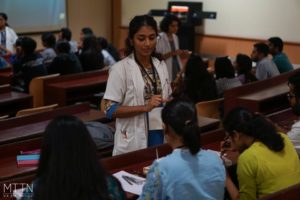
Jigsaw
Inspired by the movie series, Jigsaw was a grand forensic puzzle organized by Justitia involving seven teams of four participants each. Spread all over the campus, the murder hunt kept the participants on their toes both physically and mentally. Each scene was designed based on a forensic principle or topic with the criminal brilliance akin to the character jigsaw. The participants were to solve all puzzles in a room to move on to the next. The series of crimes finally led them to the last one; the most baffling one. The air was filled with loud gasps and the ground with scratching heads. In the end, the Justitia team unentangled the mystery to the participants and explained the forensic significance of each station. The participants enjoyed the experience and showered the organizers with praise.
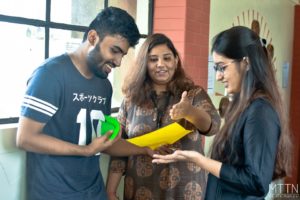
EM Simulation
The Simulation lab was astir with the sound of footsteps and conversation, and it wasn’t the CPR manikins coming to life. Around 45 participants had arrived for Tempus Pretioso’s EM Simulation workshop, held as part of IGCLA.
After a briefing session by the Tempus team, the participants were split into 6 groups, with each group going to 2 case scenarios (a snake bite and a cardiac arrest) with a MedRelay session in between. Modulated by the EM department’s very own Dr. Prithvi and Dr. Vimal, participants had to diagnose and treat their simulated patients exactly how they may one day treat their real patients. With time running out and the patient’s condition deteriorating in front of their eyes, the true challenge was keeping calm under the pressure and recollecting theoretical knowledge to apply it effectively, at which some teams fared better than others.
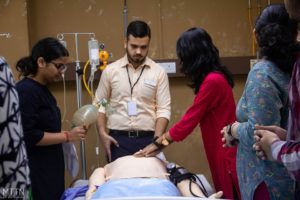
Angioplasty Simulation
The workshop, conducted by Dr. M Sudhakar Rao, assistant professor at the Department of Cardiology, KMC-Manipal, aimed at giving a sneak peek into the field of cardiology to undergrads. Followed by a brief introduction, he demonstrated the techniques of angiogram and angioplasty on a high fidelity manikin. Around 20 delegates from various colleges of the south zone participated in the workshop. They got a hands-on experience on a simulation that involves post-graduate level mastery. They were taught how to prepare the patient, drugs to be administered, precise identification, calibration and use of all the instruments.
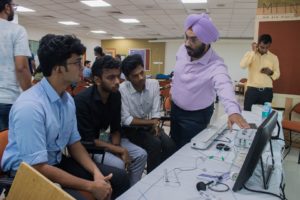
Surgical Stapler
A workshop on ‘Stapler Bowel Anastomosis’ was organized by Dr.Nawaz Usman, assistant professor, Department of Surgical Oncology. He began the presentation with a brief introduction regarding the prerequisites, indications, and precautions for the procedure. He also explained the types of anastomoses and the merits of using staplers over the conventional hand sewing techniques. This was followed by a lecture by Mr. Kaushal Kumar Pathak, a representative from ‘Johnson and Johnson’ to explain the various types of staplers available in the market and the manufacturers’ point of view. This presentation was followed by a demonstration by Dr. Nawaz in which he performed the anastomosis on a small bowel specimen. After explaining and demonstrating, the delegates were given an opportunity to perform the anastomosis themselves and practice to get hands-on experience.
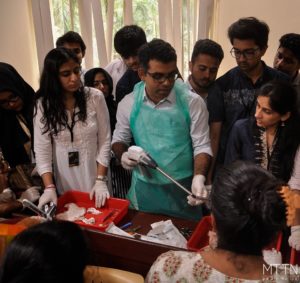
Warzone Medicine
The Warzone Medicine workshop took place at the Interact Building. It was conducted by Dr.Murtuza from St. John’s Medical College, who has traveled to Iraq on behalf of Médecins Sans Frontières (MSF) and Dr.William, a KMC faculty who has travelled to Orissa, Kashmir, and Nepal as a part of St. John’s missions.
The workshop involved both these skilled doctors sharing their experiences working outside the usual clinical setup. Dr.Murtuza touched upon his experience in Iraq from getting clearance from four different armies in one country to using a water column and a discarded, normal saline bottle as a BiPAP and an asthma pacer respectively.
The audience also got a taste of these experiences by enacting certain scenarios of being able to get army clearance or on how to deal with a trauma patient in a setting with limited resources. The atmosphere and the response from the crowd were enthusiastic and infectious, who were all ears when the doctors were sharing their experiences.
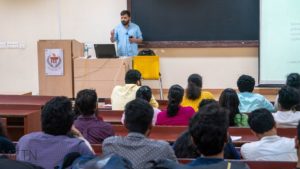
Murder Mystery Dinner
The Murder Mystery Dinner, arranged by Justitia and the IGCLA team, took place in TMA Pai Hall on the night of the 19th of September. A Cluedo-esque event, it was a perfect ending to the activities of day one. Justitia is known around the country for its one of a kind thriller workshops. The organizers and participants were dressed to the theme of an upscale restaurant dinner. The theme was complete with servers, celebrities, comedians and crimes. The hall was dotted with clues masked by the superior performance of the team. The delegates were left at the end of the night with a wonderful experience and a sense of curiosity tickling their mind.
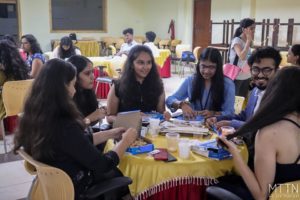
Day 2, Friday
The second day began with an inauguration ceremony followed by a talk by Dr. Naina Arora who spoke on immune-modulation by T. solium excretory protein. The audience was then part of a pro-recognition regarding the pursuit of higher studies in Germany.
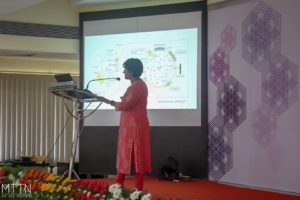
The whole day was dotted by case presentations by the delegates at TMA Pai Hall-2. From topics ranging between preclinical subjects like biochemistry to super specialty topics like neuro-surgery, the presenters gave the evaluators a tough time. The evaluators were keen and encouraging of the young undergraduate research spirit.
On the third floor of TMA Pai Halls, a whole new level of adrenaline battles were brewing. It was the grand finale of the third edition of Wearable Devices Hackathon. The preliminary rounds for the same were held 4 days ago. 18 interdisciplinary and inter batch teams that were formed after a primary meet on the 20th competed at the qualifying round. 8 teams got selected and had a face-off at IGCLA. Dr. Arun Shanbag, Dr. Suma Nair, Dr. Jayraj and Dr. Anil Bhat were judges of the event. Following were the devices presented: –
1) Stabralize: an electronically controlled self-learning bra. It understands movement and anti-movement. It is a sports bra with aimed at maximizing comfort and reduction of movement. It is made of components that can be strapped on any bra that the user deems comfortable.
2) HelmeTech: A helmet implantable device which lets the user start his bike only upon wearing a helmet. It also activates emergency response services during accidents. It is basically an integrated accident reduction and safety system.
3) Labour+: A notification device of true contractions in labor which signals when it’s time to leave for the hospital. Affordability and availability of rental services were unique to this idea.
4) Shot trackers: A shoe sole implantable device that aids in the prevention of injuries in amateur basketball players. It mostly reduces debilitating ankle injuries
5) VisAid: A clip-on filter with a spring mechanism for the color blind, photophobic and dim light readers.
6) TemperVib: by team ‘A must Have’: A device for relief from muscle soreness and joint pain/inflammation. Combination of vibratory and heat therapy was a unique idea.
7) Shishu Kavach: neonatal temperature regulation and respiratory rate monitoring system.
8) Babysafe: Internet of Things and NST based monitor. Fetal movements, heart rate, and oxygenation are calculated by it. Sensors on the device send emergency signals to the nearest healthcare professional.
Novel ideas, challenging manufacture plans and marketing strategies heated up the stage with the fire of biomedical engineering. The ideas and the spirit with which they were pursued was highly inspiring.
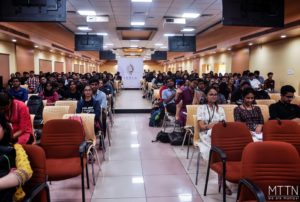
At the end of the day-2, The Literary, Debating and Quizzing society of MIT organized the ‘General Quiz’ which was conducted in TMA Pai hall-2. The quiz was co-ordinated by Mr. Sahil Shah and Ms. Sachi Tengse. The delegates were divided into teams, each of which consisted of three members or less. The quiz included a wide variety of topics ranging from ancient mythology to famous movie dialogues and political revolutions. For the preliminary round, the questions were projected and the delegates had to write down the answers in the sheets provided. Eight teams qualified for the finals which were a mixture of ‘dries’ and pounce/bounce. The winning team was declared shortly after the quiz.
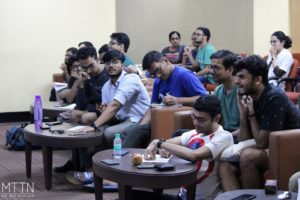
With this, the events of the first couple of days came to an end. Stay tuned for a glimpse into the activities of the next two days.
Leave a Reply
You must be logged in to post a comment.